Articles
Omar Ramsden and the CNE
Abstract
The Canadian National Exhibition, founded in Toronto in 1879, developed rapidly in the early 1900s into the world's largest annual fair. Its impact on popular culture and material culture has yet to be explored by scholars. Between 1910 and 1939, a small but significant aspect was the exhibition and sale of Canadian, British and international art at a level unparalleled elsewhere in Canada at the time. By 1922, this had evolved to include modern applied art by prominent British artisans. The Arts and Crafts silversmith Omar Ramsden (1873-1939) was one of the most consistent exhibitors, showing nine times between 1922 and 1934. This study surveys the history of the Applied Art section and identifies Ramsden's exhibits from archival and other sources. Other newly discovered evidence of Canadian taste for fine contemporary silver is also presented.
Résumé
L'Exposition nationale canadienne, fondée à Toronto en 1879, est devenue au début du siècle la plus importante foire annuelle du monde entier. Les chercheurs n'ont pas encore cerné ses répercussions sur la culture populaire et la culture matérielle. Entre 1910 et 1939, un aspect secondaire mais significatif a été l'exposition et la vente d'œuvres d'art canadiennes, britanniques et internationales à un niveau sans parallèle ailleurs au Canada à l'époque. En 1922, cette évolution englobait d'importants adeptes britanniques des arts appliqués modernes. L'orfèvre Omar Ramsden (1873-1939) du mouvement Arts and Crafts, l'un des exposants les plus assidus, a présenté des œuvres à neuf reprises entre 1922 et 1934. La présente étude retrace l'histoire de la section des arts appliqués et décrit les expositions de Ramsden à partir de sources archivistiques et autres. Elle présente également des preuves nouvellement découvertes de l'intérêt manifesté au Canada pour l'argenterie contemporaine.
1 The Canadian National Exhibition was formally established in 1879 as an annual exhibition and fair in Toronto, Ontario.1 It focused on industry and agriculture, combining displays of the latest household goods and foodstuffs by manufacturers and retailers with agricultural products, contests, demonstrations, horticulture, athletic events, concerts, popular entertainment, and a midway with sideshows. Although between 1900 and 1940 it lasted for only two weeks, running from late August to early September, it ranked as a major annual attraction (Fig. 1). Popular theme parks were then virtually unknown, and fewer people enjoyed access to automobiles or travel.
2 After World War II, the "Ex," as it was affectionately called by Torontonians, still retained its importance as a place for displaying the latest model automobiles and home appliances, cooking shows by media personalities, contests, and theme days. By the late 1950s, its influence on popular culture was being increasingly eroded by television, glossy magazines, and other vehicles of merchandising. Even though five of its original buildings dating from 1905 to 1912 have been carefully preserved as a virtually unique survival of early twentieth-century exposition architecture, today the CNE is best known for its midway and bandstand shows, and for events that use its facilities and 200-acre site at other times of the year, like the Royal Winter Fair and the One of a Kind Craft Fair. But that was not always the case.
3 A small but important aspect of the Canadian National Exhibition before 1940 was the formal exhibition of art, graphic art, applied art and photography. Shows of art and crafts were a part of many of the large regional fairs that began to be held in Canada in the mid-1800s. These fairs tended to focus on agriculture, where much of the commerce and wealth was concentrated at the time. The art at the fairs was intended to elevate the tone of the event and to enhance its cultural value.
4 Art could also serve as a popular attraction. For example, a poster for the 1890 CNE advertises the exclusive display of "... the celebrated $100,000 Painting by the great Russian Artist Makoffsky, entitled: The Preparation of the Bride," which cost over $2 000 to insure.2 By 1900, the art section had developed into a display of largely traditional pictures by leading members of the Royal Canadian Academy. Nearly all exhibits were for sale. Specially published catalogues from the period included illustrations of some of the paintings and small photographs of many of the artists.
5 In 1902, a permanent Art Gallery in the popular Beaux Arts style, complete with a classical temple facade, had been erected on the CNE grounds. The first Gallery proved too small, and ". . . a fire-proof Art Gallery, the most complete of its kind on the Continent of America" was built in similar style for the 1905 CNE.3 It was ". . .128 by 32 feet [39 by 10 metres], constructed in quadrangular form."4 Beginning in 1909, the original Art Gallery became a venue for displaying graphic art, photography and applied art. These galleries were a significant facility in the context of the times. The Art Gallery of Toronto (now Ontario) and the Royal Ontario Museum (opened in 1913) did not exist, and few Canadian cities supported an art gallery of greater size.
6 Though held for only two weeks, by World War I the annual art shows had grown to include a loan exhibition of important foreign work as well as pictures by established Canadian artists. For example, in 1913, German paintings were featured and, as a prelude of what was to become the Applied Art section, a display of porcelain from the Royal Berlin Factory. The porcelain included "The Wedding Procession," a series of figurines to form a table centrepiece, designed by the sculptor Adolf Amberg (born 1874) for the wedding of the German Crown Prince in 1905. These figures had attracted considerable interest at the Berlin art exhibition of 1911 and are still considered masterpieces of early twentieth-century design and ceramic sculpture.5 Perhaps it was a reflection of the international aspirations of the CNE art commissioners radier than the politics of the times that "The [Art] Committee approved of an Austrian Art Exhibit for 1914, the pictures to be selected by Mr. Dibdin."6 During World War I the art shows continued on a reduced scale.
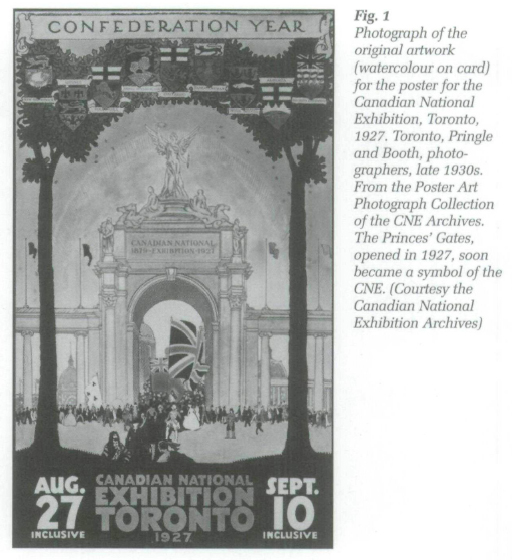 Display large image of Figure 1
Display large image of Figure 17 The minutes from the meetings of the Department of Fine Art, held once or at most twice a year, are brief, mostly one page type-written, and begin in 1913. They seem to be the only primary documentation surviving for the art shows in the CNE Archives. Nonetheless, they are indicative of key decisions and important trends. In the minutes of 8 April 1918, "It was resolved. . . That Mr. Jefferys and the Secretary try and arrange for a modern exhibit of applied art, and report the same to a future meeting of the Art Commission."7 Charles William Jefferys (1869-1951) was a well-known illustrator and historical artist. The painter Frederick Stanley Haines (1879-1960), who served as secretary, was then an Associate [Member] of the Royal Canadian Academy ("ARCA") and a member of the Ontario Society of Artists (OSA). Ultimately, he served as President of the OSA and became a member of the Royal Canadian Academy.
8 Judging from the list of the commissioners and the minutes, Haines continued to play a key role in the art and applied art exhibitions right up to 1939. The minutes around 1930 refer to him variously as the "Art Commissioner," the "Art Director" and the "Director" of the Art Gallery, and there were unsuccessful attempts at gaining his membership in the Association of Curators of Art Galleries (U.S.A.) in the hopes that this would ensure access to a wider range of important U.S. and foreign loan exhibitions.8 Frederick Haines likely played an essential role in negotiating the loan of modern applied art. A note in the minutes for 26 March 1924 states that "Mr. Haines advised that he had written to a number of craftsmen in England [sic] in regard to art craft and jewellery."9 He also travelled to Denmark to select the paintings and ceramics, silver, glass and metalwork that were the highlight of the 1929 Applied Art display.10
9 Another figure whose contribution to the art exhibitions appears to have been considerable was Mr Edward Rimbault Dibdin (1853-1941), who, between 1904 and 1918, was the second Curator of the Walker Art Gallery in Liverpool. Born in Edinburgh, Dibdin was an art critic, writer and promoter of Liverpool artists who served as President of the Museums Association, 1914-1918.11 E. Rimbault Dibdin was European Representative for the Art Commission of the CNE from 1910 to 1914, again in 1918 and from 1922 to 1934.12 As described in the minutes, Mr Dibdin's duties seem to have been primarily finding, selecting and arranging for the shipment of suitable paintings and occasionally sculpture, either as individual pieces or complete exhibitions.13
10 However, he also appears to have been instrumental in organizing the applied arts. Dibdin's letter of 16 December 1911 to Dr J. Orlando Orr (1861-1917), manager of the CNE, reports that he had been corresponding with his cousin, Miss Sara B. Guthrie, about the idea of providing a small exhibit of "decorative work" and requests Orr's guidance on the number and type of pieces that would be desirable.14 After repeated efforts, in 1922, once the "modern exhibit of applied art"15 became a more or less regular feature in the smaller CNE Art Gallery, it usually included work by English potters and metalworkers, a number of whom are recognized today as prominent figures in English applied arts between the wars. Among the recurring exhibits was tooled metal by Sara B. Dibdin, who became her cousin's second wife sometime between 1911 and 1922.
11 The first "modern exhibit of applied art" in 1922 coincided with the publication of a new and larger catalogue that described all of the works and, except for 1923, stated the prices. The entire contents of both Art Galleries were listed in sequentially numbered entries, grouped by medium, with individual artists appearing in alphabetical order: oil paintings, occasionally sculpture, graphic art and watercolours, applied art, and in a separate section, The Toronto Salon of Photography. The Salon was organized by the Toronto Camera Club and included submissions from all over the world. A few key pictures and photographs were occasionally illustrated. Between 1922 and 1939 the catalogues maintained the same format with a bold woodblock cover in strong monochrome colour showing Canadian or Group of Seven themes. The majority were designed by the illustrator Thoreau Macdonald (1901-1989).
12 In most years, the selection of art followed the formula of Canadian paintings, watercolours and graphic art; English paintings, watercolours and graphic art (often with a section devoted to small works from the Royal Society of Miniature Painters, Sculptors and Gravers); and English applied art, sometimes with a separate smaller selection of Canadian pieces. Perhaps because of the extra work involved and the strong British interests of the Canadian audience of the time, British and Canadian art always formed the core of the exhibitions, with varying additions of foreign paintings, graphics and applied art. These additions included: Spanish art in 1922; Swedish in 1923; American in 1924; contemporary Russian art and applied art in 1925; American and Italian art in 1926; Belgian and French paintings in 1927; Spanish paintings and Mexican applied art in 1928; art and 1156 pieces of applied art from Denmark and American mural sketches in 1929; an all-Canadian show in 1930; Scottish paintings, selected Old Master paintings and stained glass in 1931; American paintings in 1933; French art and applied arts in 1937; and Surrealist art and design drawings for the theatre in 1938. Although this study concentrates on a single notable artisan in the Applied Art section, the art and photography sections as documented by the catalogues offer considerable information that could be explored profitably by art historians and scholars.
13 It is difficult to gauge the success of the Art and Applied Art exhibitions at the Canadian National Exhibition. The sales recorded were often modest. Few pieces, other than foreign art, seem to have been sold on commission, and duty was payable on all imports. In the minutes for 13 January 1928, it is recorded that
14 Perhaps these instructions contributed to the success of the following year documented in the minutes, where "The Commissioner reported 173 sales in the 1928 Exhibition, amounting to $8,523.15. Also that the Art Galleries, during the fourteen days of the Exhibition period, were visited by 110,000 people."17 This is arguably the largest attendance for any art event in Canada prior to 1950, and one that was never exceeded by the Art Galleries at the CNE.
15 Among the English artisans who displayed with the greatest consistency at the CNE was the silversmith Omar Ramsden (1873-1939). Ramsden followed the Arts and Crafts tradition, deriving particular inspiration from English Medieval and Tudor silver. Between 1898 and 1918, with his partner Alwyn Charles Ellison Carr (1872-1940), he established a reputation for hand-wrought silver of Arts and Crafts design and attracted commissions from corporations, churches, professional and military organizations, and individuals who wanted specially designed or presentation pieces.
16 Ramsden and Carr dissolved their partnership after World War I. Both continued to work silver and sometimes other metals in a similar, though often more simplified, Arts and Crafts style, with hand-beaten finishes, occasionally enhanced by enamel panels or semi-precious stones. Ramsden's reputation as a key figure in twentieth-century design and silversmithing continues to grow.18 Although commercially manufactured English silver may have been available elsewhere at the CNE, Omar Ramsden is the only silversmith who consistentiy showed in the Art Galleries. From 1922 to 1927, and then in 1929, 1931, and 1934, he displayed a total of 141 pieces, everything from gold cuff links in 1923 to a large vase with a cover surmounted by St George in 1926. Most of the work displayed was less expensive than his. His lowest and highest priced pieces were shown in 1931: no. 1419, a "Fruit Dish" costing $380 and no. 1439, a "Butter Spreader" costing $4.75.
17 Omar Ramsden is unique among the exhibitors of applied art because many of his objects can be identified from archival material, and actual pieces are gradually being located. Nineteen ledgers from his workshop are preserved in the Library of Goldsmiths' Hall in London, England. Most pages show outline drawings of models and include notes by Ramsden himself recording cost, production, and sales. These ledgers were generously donated by the silversmith Leslie Durbin, who served his apprenticeship in the Ramsden workshop (1929-1936) and continued to work there until 1939.
18 Considering that Omar Ramsden probably never employed more than ten craftsmen in his workshop, he was exceptionally successful at securing prestigious commissions and in publicizing his work. His personal philosophy of making silver better known to the public is suggested in a slide-illustrated lecture, "Some Aspects of Modern Silverware," that he delivered at Goldsmiths' Hall on 8 March 1928.19 The typed text of the lecture not only reveals his personal ideal of design but provides a constructive critique of contemporary silver design and the way in which silver was being marketed in England at the time. In his concluding remarks, he urged that ". . . in order to perpetuate this age in the Renaissance of the silversmith's art, it will be necessary to hold exhibitions on a large and extensive scale."20
19 Ramsden appears to have been more than willing to undertake commissions from the British colonies and to assume the risk of displaying his wares in far away places in the hopes of sales and potential clients. Records exist of his commissions for the cathedrals in Colombo, Sri Lanka; Bermuda; Detroit, Michigan; and Cairo, Egypt, as well as orders from Australia and New Zealand and sales through a shop in Detroit.21 As the largest annual fair in the world, the Canadian National Exhibition opened a potentially valuable market. In 1929, when Danish Applied Art constituted the featured exhibit, Ramsden still managed to show four pieces as a member of the Royal Society of Miniature Painters, Sculptors and Gravers.
20 Since photographic documentation for the Applied Art exhibitions does not appear to have survived, the ledgers at Goldsmiths' Hall offer the most profitable opportunity for investigating the range of pieces shown by Omar Ramsden at the ONE. Models in these unnumbered ledgers are organized more or less by forms that are chronologically and consecutively numbered, though those of the late 1930s include a wider range of pieces. For instance, the first volume is titled crudely in pen on the front "1 -150 Cups & Bowls." Where the entry in the Art Catalogue of the CNE includes a pattern name, title or some distinctive wording, it is often possible to associate the object shown with a specific model named and illustrated by a line diagram in the ledgers. Ramsden's notations on the ledger page provide evidence of the original production date, when further versions were made, whether one was made "for stock," the price(s) in code, and other details that can confirm it as one available for showing at the CNE.
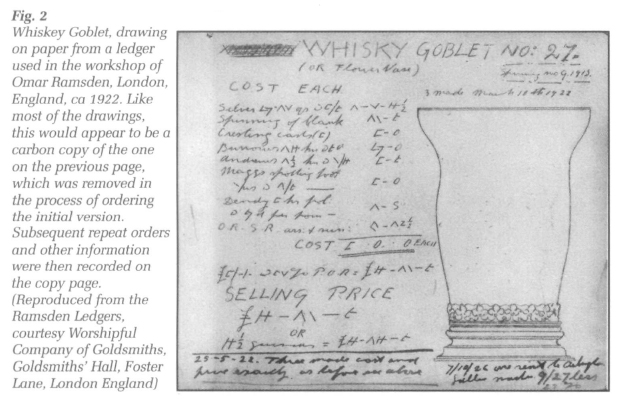 Display large image of Figure 2
Display large image of Figure 221 The price can be especially useful confirmation. Ramsden liked to state his retail prices in guineas, a sterling coin worth one shilling more than a pound. Though no longer used, guineas had been a standard unit for pricing art and luxuries since the 1700s. In the 1920s and 1930s, an English guinea seems to have been worth about $8 Canadian. Interestingly, many entries in the CNE Art Catalogues followed wording that was distinctive to Omar Ramsden. For example, fine surface finishing of silver with tools, which is commonly referred to as "chasing," is described with Ramsden's term as "chiselled." "Grape fruit" is also a rendering found in the Ramsden ledgers. His silver is described as "Beaten," "Hand-Beaten," and "Wrought" to emphasize that the pieces were handmade in the best Arts and Crafts tradition.
22 Over forty of the 141 pieces shown by Ramsden can be identified with some certainty from his shop ledgers. Entries for these taken from the Art Catalogues are listed below under consecutive years followed by abbreviated quotations from the ledgers and comments. Dollar signs are inserted for entries from 1922 to 1929. Ramsden's prices have been converted from his personal code:
"1390. Cigarette Box, 'Sir Walter Raleigh's Ship' in wrought silver and enamel. $53.00" most likely relates to "Single PANEL RALEIGH BOX NO: 183 Finished March 23rd 1922— . . ." Price 8 guineas. A variety of cigarette boxes with panels showing sailing ships appear in the Ramsden ledgers.
"1391. Inkstand in beaten and repousse silver. $53,000 [sic]." This could be any single ink-well model between no. 155 and 162.
"1392. Penholder in hand-wrought silver. $6.50" appears to be "PEN HOLDER NO. 179 . . . 6 made for stock Feb 3rd 1922." The form is based on a late gothic column. The metal nibs at the tip of this straight pen periodically would have to be replaced.
"1393. Scent bottle in silver and glass. $53.00." This form is rare in Ramsden silver. Only two models appear in the ledgers. Although the price of 8 guineas seems to be more, based on the date, this may be one of three "ROSE AND LILY SCENT BOTTLE[S] No. 633" made 17-2-22. "1394. Whiskey goblet. $53.00" "WHISKY GOBLET NO: 27 ... 3 made March 10th 1922" (Fig. 2 ).
"1119. Ship Spoon, in Hand-chiselled Silver." "Ship Spoon No: 454."
"1120. Cigarette Casket, in Handbeaten Silver, with fine Blue Moonstones and Translucent Enamel Panels: 'Jacques Cartier's Quest'. A.D., 1535." This is one of the occasions where Ramsden labelled a piece to appeal to the local audience. The only entry in the ledgers corresponding to this is '"Raleigh Ship' [script] MOONLIGHT SHIP CIG: BOX No. 151/ old No. 261/ Finished April 12th, 1921." Five versions had been made by 5 May 1923 (Fig. 3).
"1121. Tudor Rose and Thistle Bowl in Beaten Silver." "Rose & Thistle [Bowl] - No-61."
"1123. Cigarette Case 'Tobacco Flower' in Repousse Silver." Most likely "NICOTINE SINGLE FLOWER CIGARETTE CASE" no. 614, first made 19 September 1921. Selling price £5-5/-0.
"1128. Maple Syrup Ladle in Chiselled Silver." "TINY SYRUP LADLE NO.509 . . . 2 Finished 1-12-22." Again, as in 1120 above, Ramsden apparently adapted the name to suit the market.
"1131. Paper Knife in Chiselled Silver, 'Ship'." "SHIP PAPER KNIFE No. 507."
"1132. Pendant in Hand-wrought Silver, with Garnets and Translucent Enamel." This could be model 647, 648 or 649: 647 is the most likely because it was made for stock, 27-11-22, which means that it could have been available for display.
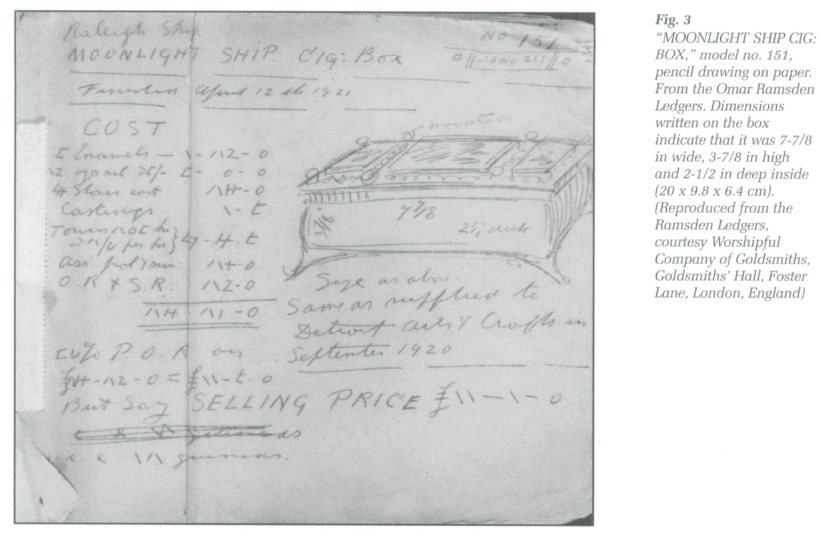 Display large image of Figure 3
Display large image of Figure 3 Display large image of Figure 4
Display large image of Figure 4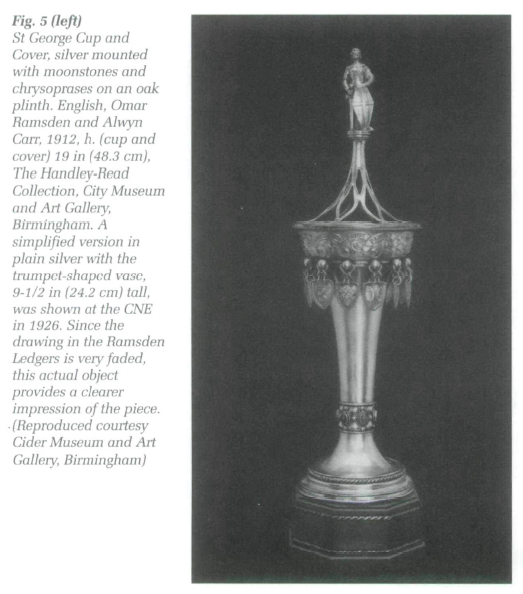 Display large image of Figure 5
Display large image of Figure 5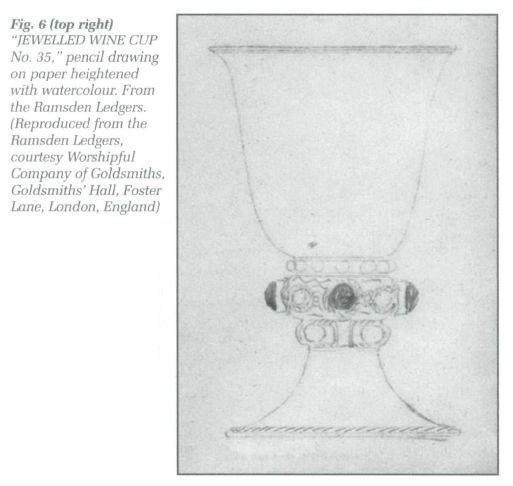 Display large image of Figure 6
Display large image of Figure 6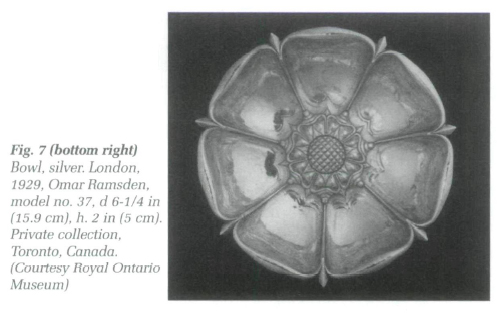 Display large image of Figure 7
Display large image of Figure 7"1302. Cigarette Casket in Silvered Bronze with Panel of Translucent Enamel. $65.00." Possibly the round "Edward I CIG: BOX SILVERED COPPER No 164." Selling price 8 guineas.
"1309. Wine Cup in Beaten Silver. $30.00." Possibly "HEART KNOP WINE GOBLET No. 51," selling price £3 13/6 p. Few entries for this year have distinctive wording.
"1139. Roman Leaf Cup or Goblet in hand-wrought and chiselled silver. $37.00." Model no. 38 introduced 12-6-22. Ramsden states "Entirely apprentice work & in order to keep cost down I have omitted supervision, etc., of which there has been a good deal." He also records a "REPEAT OF SIX ROMAN LEAF CUPS NO 38 March 17th 1924."
"1141. Cigarette Lighter, Spirit Lamp, 'Fiat Lux' in handwrought and chiselled silver. $47.00." A cigarette lighter in the form of a classical Roman lamp with this lettering, model no. 377, was first made on 14 February 1924 (Fig. 4).
"1142. Cigarette Box, 'Sir Walter Raleigh's Ship,' in handwrought and chiselled sterling silver. $63.00." Based on price, this may be a version of model no. 183. See 1390 in 1922.
"1238. St. George vase and cover: centre-piece or flower-vase; in hand-wrought and chiselled silver. $211.00." This is model no. 75 with cover no. 77. It resembles a larger model originally produced by Ramsden and Carr (Fig. 5). A number of Ramsden models from the 1920s and 1930s seem to be a continuation of ones developed earlier in his career.
"1239. Grape fruit bowl in hand-wrought silver. $33.50." Three models of hemispherical bowls on a foot for serving half a grapefruit are illustrated in the Ramsden ledgers: nos. 133,135 and 137. Based on the four guinea price and the showy decoration, this is likely no. 137. At the time, grapefruit was an imported luxury.
"1348. Finger Bowl in beaten and repoussé silver and enamel. $70.00." This is the "ROSE FINGER BOWL No. 146," priced at 8 guineas.
"1350. Wine Goblet in wrought silver and jewels. $55.00." The "JEWELLED WINE CUP No. 35" is the only goblet with red stones mounted around its stem. Price £6 16/ 6 p. It appears to be the only drawing in the Ramsden ledgers where watercolour is used to highlight the details (Fig. 6).
"214. 'Tudor Rose' (handwrought silver bowl, fellow to one recently made for H.M. the Queen). $50.00." This is probably "SMALL 'ROSE' Rosebowl No:37", a smaller (6-3/8 inch diameter) version of no. 33. Selling prices ranging from 7 to 10 guineas are recorded for this model in the Ramsden ledgers; however, three were made on 23 October 1922, at a cost of £4 6/ (about $34 Canadian), which makes a selling price of $50 Canadian credible in 1929.
23 The British Royal Family enjoyed great popularity with the Canadian public between the wars. In 1927, Edward, Prince of Wales, and his brother George, the Duke of York (later George VI), visited Canada and opened The Princes' Gates, a commanding neoclassical triumphal arch at the eastern entrance to the CNE grounds. Two examples of 'Tudor Rose' bowls by Ramsden with 1929 hallmarks were sold recently in separate auctions in Toronto and apparently came from local estates22 (Fig. 7). Perhaps they were acquired as a result of Ramsden's display at the CNE. A third one made in 1934 descended in the family of a Toronto man who regularly visited the Applied Art exhibitions and made purchases from the artisans displaying there.23
"1404. 'Thistle' Mustard Pot. $40.00." Model no. 432. Price 5 guineas.
"1405. 'Thistle' Pepper Pot. $30.50." Model no. 433 (Fig. 8).
"1406. 'Thistle' Salt Cellar. $36.00." Model no. 434. Price £4 14/ 4p.
"1409. 'Thistle' Spoon. $8.00." Model no. 458.
"1411. 'Rose and Lily' Spoons in Case. $22.75." "Lily" spoon model no. 457 and possibly "TUDOR ROSE NO 459."
"1414. Thistie' Knife in Case. $9.50." Probably small Thistle butter knife model no. 588.
"1416. 'Pine Cone' Beaker. $40.00." "PINE CONE BEAKER - CUP 1337 ... Price £5-5/-0."
"1417. 'Imbrication' Beaker. $40.00." "'IMBRICATION' BEAKER-CUP... Price £5-5-0."
"1418. 'Nor' Bowl. $26.50." Model no. 1346. Six were completed on 11 October 1929. The selling price of each was £3 16/ 6 p.
"1422. Roman Tazza. $61.00." This is a shallow bowl, model no. 1398. On 21 April 1932, a repeat of three was made. The selling price was 7 guineas.
"1428. Six 'Rosemary' Spoons in Case. $34.25." "NO. 477 ROSEMARY SPOON... Repeat of 12 - Feb 5th 1931." The ledgers show a variety of boxed arrangements for spoons.
"1431. Two ' Wheatear' Spoons in Case $24.75." Model no. 1555, first made 19 August 1930, and priced at £l-16/-6 each (Fig. 9).
"1432. Sugar Castor. $72.50." This may be model no. 592 for which the price is given as 9 or 10 guineas.
"1433. Salad or Vegetable Servers. $32.25." Possibly "No.1581 Solid Silver Salad Servers First made 18-11-30. . . Price not in case £4-4-0."
"1435. 'Thistlehead' Spoons in Case. $23.00." Likely "SMALL SIZE THISTLE SPOON No.587."
"1441. 'Lotus Bud' spoon. $12.50." This could be "No. 554 LOTUS HEAD PORRAGE [sic] SPOON." Five were made for stock, 27 January 1930, and priced at one guinea each. An example with 1939 hallmarks is in the collection of the Royal Ontario Museum, accession no. 941.8.51.
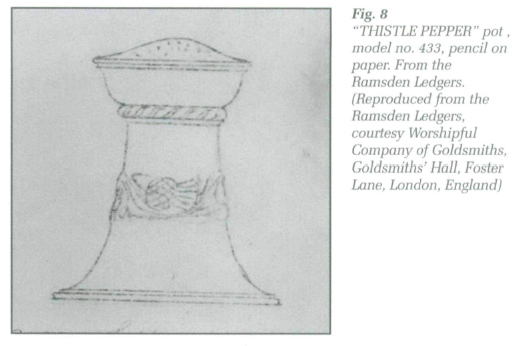 Display large image of Figure 8
Display large image of Figure 8 Display large image of Figure 9
Display large image of Figure 9"757. Three-handled loving cup or trophy $355.60." Model no. 1772, "as finished 21-4-1932 . . . [Price] say 40 guineas."
"758. 'Dolphin' Paper Weight (as made for H.R.H. the Prince of Wales) $166.75." Model no. 1888. ". . . Second example finished 17-2-1934 Weight 15 ozs. . .Price £21-0-0 which is very lowest price." The design may be a word play on "Dauphin," the French title for the heir to the throne. See comments on no. 214 in 1929.
"763. 'Raleigh Ship' Box. $88.90." Perhaps model no. 183. Variations of this model seem to have been popular with the Toronto audience. See 1390, in 1922, and 1142, in 1925. The price does not help in confirming the model.
"764. Quatrefoil Basket. $88.90." Model no. 1725. "Same as No. 1385 with handles added. . . Selling Price £12-12/-0."
"777. Acorn Spoon. $12.70." Model no. 1897. '"New Oak' spoons. First made 23 April 1934. Price £l-16/-6."
"779. Venetian Bowl. $26.75." "New Venetian Bowl No. 1860." Five had been made by 18-12-33. "Cost of original £l-18/-0."
"790. Port Goblet. $54.00." Only one model with this name appears in the ledgers, no. 39. Ramsden's notation at the bottom of the page probably records the making of this example: "On making 4 entirely by hand Jany 4th, 1933. Cost was £4 5/ each. Price should therefore be £6 6/ 6 OR."
"792. Caddy Spoon. $12.25." Ramsden produced a wide range of small scoops, commonly known as "Caddy Spoons," for measuring tea leaves from the caddy or serving sugar. Models include nos. 464 to 469, 479 and 600.
24 The range and variety of silver exhibited by Omar Ramsden at the Canadian National Exhibition constitutes one of the most significant efforts of an English craftsman to offer wares to the Canadian market. Documenting the success of his efforts through sales to Canadians will be a long and slow process. A silver bowl by Ramsden made for Waldo W. Skinner, Esq., K.C. of Montreal, as a Christmas gift for his wife Loulou in 1931, is in the collection of David Campbell in Toronto.24 The man who bought the "Tudor Rose" bowl made in 1934, noted earlier, and his brother both purchased Ramsden silver from the CNE. Some of his pieces have descended in his family, along with a silver bowl and its design drawing that he ordered from Ramsden for family christenings.25
25 Visiting Canadians were also able to purchase or order directly from Ramsden's showroom in London. At least one Canadian bride-to-be is said to have been taken there by her father to order flatware.26 This may have been the manner in which Mrs Josephine Eaton Burnside, sister of the department-store magnate Timothy Eaton, and a prominent lady in Toronto society, acquired the thirteen small pieces of Ramsden silver that she presented to the Royal Ontario Museum in 1941 (accession numbers 941.8.41-.53). Although at least two of the flatware pieces correspond to models shown at the CNE, the 1937, 1938 and 1939 hallmarks indicate that Mrs Burnside had purchased them after Ramsden had ceased exhibiting.
26 After 1939, special exhibits of art and applied art were no longer organized by the CNE, partly because of World War h and partly because of rising costs. The Art Committee did not meet again until 28 May 1948, and no formal art shows have been organized since 1984. The impact that the exhibits of fine British contemporary applied art may have exerted on Canadian taste and local craftspeople between 1922 and 1939 is difficult to assess. There is some evidence that these exhibits enhanced the credibility of Canada as a market for fine British silver. On 18 April 1935, Mr C. R. Chisman, who had replaced E. Rimbault Dibdin as the art director in Europe for the CNE, wrote to Mr G. R. Hughes, the assistant clerk of the Worshipful Company of Goldsmiths, to enquire how he might borrow two pieces of silver shown at the recent Royal Academy Exhibition of British Art in Industry.27 One of them, a beaker by Edward Spencer of the Artificers' Guild Limited in London, was not available. However, Spencer replied promptly to Hughes on 1 May 1935: ". . . I am glad indeed that this piece has found favour with the Toronto authorities who have a reputation for caring for standard. I will certainly make a replica of the beaker [for display at the CNE]."28 On 13 May 1935 Spencer wrote to inform Hughes that the finished replica was available for pickup at his premises at 30 Grosvenor Street in London.29 Edward Spencer's readiness to oblige suggests that the exhibits of applied art at the CNE were recognized as a significant event by British craftspeople.
27 Further evidence of the taste for fine British silver of contemporary design is found in File 0.11.3(17) "EXHIBITIONS ABROAD 1936 Canada (Henry Birks & Sons)" preserved in the Library of Goldsmiths' Hall. In this file, correspondence and artifact lists dating 1934 to 1936 document the evolution of a major exhibit of approximately one hundred pieces of "British Silverwork by Well-known Designers and Craftsmen of the Present Day Lent by the Worshipful Company of Goldsmiths of London." Sterling, silverplate, chrome and glass were included. The exhibit was shown at Henry Birks & Sons in Montreal, in March, 1936; at Birks-Ellis-Ryrie Limited on Yonge and Temperance Streets in Toronto, 1-14 April 1936; and before returning to England, in New York under the auspices of the British Empire Chamber of Commerce, who requested the loan of the "Toronto Exhibit" in a cable dated 7 April 1936 to Goldsmiths' Hall. Evidently, even in the limited luxury market of fine silver, Canadian taste had developed by the 1930s to encompass an appreciation of the latest international styles.
The author appreciates the help and encouragement that many people gave him for this project. Mrs Joan Thompson, a valued volunteer and Board Member at the Royal Ontario Museum, first drew his attention to the exhibits of applied arts at the CNE and the Omar Ramsden silver. Ms. Linda Cobon, Administrator, Records and Archives, at the Canadian National Exhibition Archives, facilitated his study of original documents and answered many questions. Mr David Beasley, Librarian, Goldsmiths' Hall, London, gave ready access to the ledgers from the Ramsden Workshop and related material, answered questions, and generously provided photographs from the ledgers. Mr Alex Kidson, Curator of British Art, National Museums and Galleries on Merseyside, Walker Art Gallery, Liverpool, supplied essential information on Edward Rimbault Dibdin.